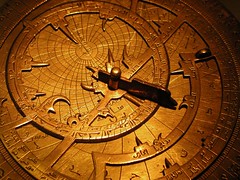On Tuesday, November 13, the Writing and Communication Program will sponsor a symposium on How Medieval Technology Can Teach the Past. The symposium will foreground the ways in which knowledge of history informs technological development today and allows faculty from different programs and schools across Georgia Tech to collaborate and discuss pedagogical methodologies used to effectively deliver and contextualize historical content.
The event, which will take place from 12:00 – 5:00 pm in the Student Success Center, Press Room B, is open to the Georgia Tech community. The symposium is comprised of three sessions: the first two sessions feature Georgia Tech faculty discussing medieval and early-modern technology and how they teach such topics to their 21st- century students. The last session showcases faculty who use modern technology, such as video games and GIS, to teach aspects of medieval and early modern history and culture. Please join us for one or more sessions to learn about the innovative ways Georgia Tech faculty teach the past!
Symposium organizer Kellie Meyer (PhD, Brittain Fellow, Writing and Communication Program) has put together a program that features the work of scholars in the schools of architecture and biology as well as Literature, Media and Communication and Digital Media. Meyer’s objective in putting the program together was to demonstrate how the technological advances and refinements of the medieval and early- modern periods (roughly 500-1700 CE) advanced civilization in ways that still inform the Georgia Tech curriculum today. You can read more about Kellie’s experiences teaching medieval studies topics to Georgia Tech undergraduates in her recent TECHStyle piece “Tech Gets Medieval” and Other Ways We Teach the Past.”
Tech Gets Medieval Symposium Schedule
OPENING REMARKS (12:00-12:30):
Richard Utz. Chair,Literature, Media, and Communication department
SESSION 1 (12:30-1:45): Modern Ramifications of Medieval Traditions
- “Medieval Construction – Foundation of Today’s Industry” (Brian Bowen, Professor of Practice, School of Building Construction, College of Architecture): A major transformation in the organizational framework of modern construction practices has interesting echoes of its medieval origins, which are relevant to understanding today’s challenges.
- “Blacksmithing and Timber-Framed Houses: Pedagogy of Risk” (Hugh Crawford, PhD, Associate Professor, LMC): This presentation focuses on two forms of medieval technological practice–timber-frame construction and blacksmithing, and how teaching students how to forge iron and chop timber is an invaluable pedagogical tool, especially in the literature classroom.
- “Biology and Germ Warfare” (Chrissy Spencer, PhD, Academic Professional, School of Biology): This presentation argues that biological or “germ” warfare is by no means a modern invention and explores the evidence for whether germ warfare may have contributed to the devastating spread of the “Black Death” in the middle ages.
SESSION 2: (2:00-3:15): Technical Communication in the Medieval and Early-Modern Periods:
- “Tried and True Methods” (Krystina Madej, PhD, Visiting Assistant Professor, LMC): This talk exemplifies how two modern teaching methods; conversational role-playing and practical application, were successfully premiered in 1000 AD by Aelfric of Eynsham, who wrote The Colloquy to help students learn Latin.
- “The Afterlives of Gawain: Illustration as Annotation in the Cotton Nero Ax Manuscript” (Leah Haught, PhD, Brittain Fellow, Writing and Communication Program): This presentation illuminates the relationship between text and image within one of the most-well known medieval tales, Sir Gawain and the Green Knight, adding much needed information about the context of its composition and reception.
- “Bind Him Together and Say, “God speed”: Mnemonic Devices in a 15th-Century English Fencing Poem” (Kate Tanski, Brittain Fellow, Writing and Communication Program): This paper discusses the rhyming verse poem “On Fencing with the Two-Handed Sword,” an example of 15th-century technical communication that offers a historical precedent for modern military instruction in today’s “popular” forms.
SESSION 3 (3:30-4:45): Using Modern Technology to Analyze and Teach the Past
- “Tracing the Steps of Touring Actors: Using REED Records and GIS to Illuminate Sixteenth-Century Performance Practices” (Diane Jakacki, PhD, Brittain Fellow, Writing and Communication Program): This paper addresses how historical records can be combined with geospatial information systems (GIS) to generate touring patterns by acting troupes; an invaluable new temporo-spatial methodology for generating a robust model of the movements of the 16th-century Queen’s Men.
- “Neo-Medieval Fantasy in Video Games” (Celia Pearce, PhD, Associate Professor of Digital Media, LMC): This paper will explore the prevalence of neo-medieval themes in video games and pose some potential reasons why these themes are so pervasive in modern-day, high-tech media.
- “Your Mission is to Rescue Lorenzo di Medici: A Demonstration of the Pedagogical Potentials of using Assassin’s Creed II for Teaching the Italian Renaissance” (Amanda Madden, PhD, Brittain Fellow, Writing and Communication Program): Based on teaching Assassin’s Creed II in an undergraduate composition classroom during the Spring and Fall semesters of 2012, this presentation explores the pedagogical potentials of a game as text to bring alive for students the social and cultural world of the Italian Renaissance.

